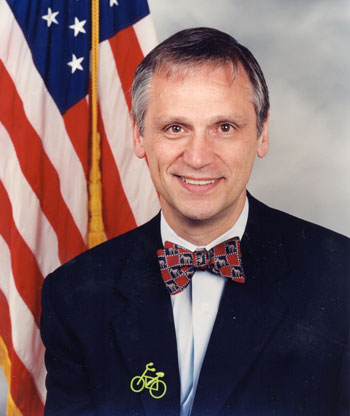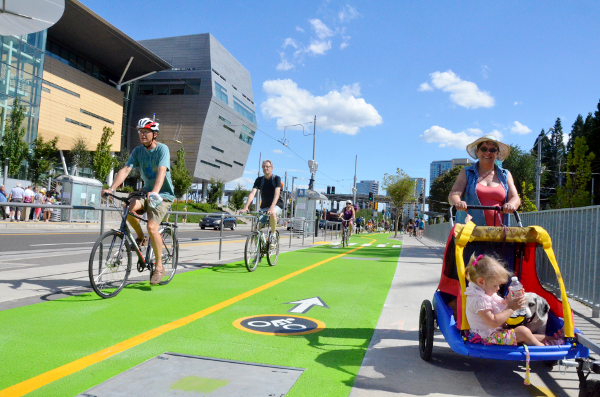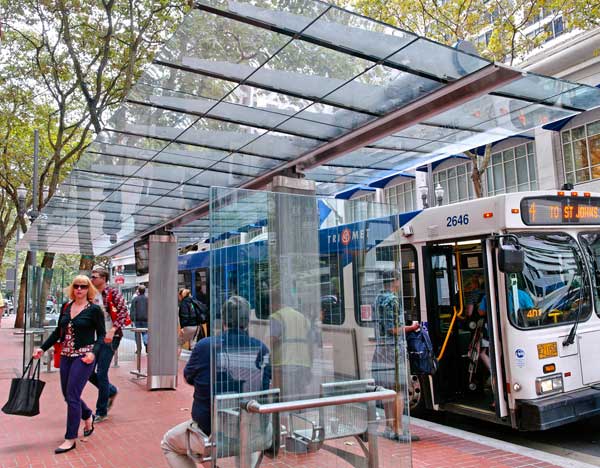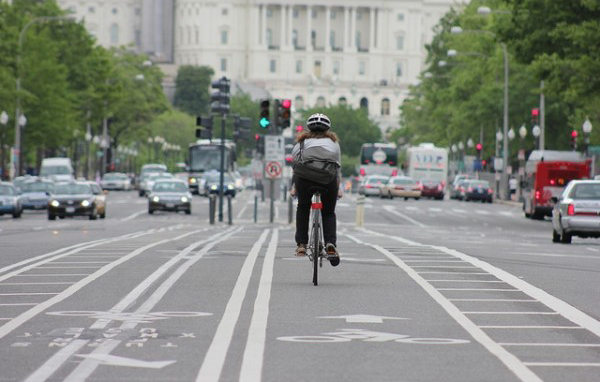News
Interview with Congressman Earl Blumenauer
 Representative Earl Blumenauer
Representative Earl Blumenauer
You sponsored CLEAN TEA, legislation that would facilitate the growth of low-carbon emission transportation alternatives, including sidewalks, bikes, light rail, and interconnected sustainable transportation networks. The idea was also to fund this out of a C02 cap and trade system. Were your ideas included? Are you satisfied with the American Clean Energy and Security Act (ACES)? Do you think it went far enough in limiting CO2 emissions, and also encouraging the development of low-C02 emission transportation?
I introduced CLEAN TEA (H.R. 1329) in the beginning of the year to start the conversation about the link between transportation and climate change. The bill would dedicate 10 percent of any revenue from a climate-change bill towards transportation projects that reduce carbon emissions. The transportation sector is responsible for about one-third of greenhouse gas emissions in this country, and it’s clear that we won’t meet our emissions reduction targets without addressing those emissions. While most climate change proposals address fuel efficiency and the carbon content of fuel, they often leave out the third leg of the stool: the amount that people drive. Studies have shown that we need to address vehicle miles traveled in order to reduce emissions to the levels necessary to meet our climate goals. The House climate and energy bill makes significant progress on the first two legs of the stool, and modest progress on the third. The bill includes language (Section 222) similar to a provision in CLEAN TEA that would require states and metropolitan planning organizations to include greenhouse gas reduction goals and strategies in their transportation plans.
After negotiations with Energy and Commerce Committee Chairmen [Henry] Waxman and [Edward] Markey and Transportation Committee Chairman [James] Oberstar, we were also able to secure a provision in ACES that allows states to use some of the revenue they receive under that legislation for low-carbon transportation projects such as public transit. The percentage is closer to one percent than 10 percent, but it’s something.
A recent Pew survey said only 49 percent of U.S. citizens think climate change is man-made; the rest see climate change as a result of natural changes, or don’t know. Additionally, if Americans are asked about top priorities (health, poverty, education), climate change always ranks low on the list. What are the best strategies for changing U.S. perceptions on this issue, which could then lead to an increased focus on sustainable transportation and other key mitigation strategies?
It’s key to continue educating people about not only the potential future impacts of climate change and the harm it will cause our children and grandchildren, but also about the impacts we’re seeing today. This spring I traveled to China and Alaska with House Speaker Nancy Pelosi and witnessed firsthand the impacts that people in Alaska are already experiencing, from receding glaciers to beetle infestation in forests to permafrost that’s no longer “perma.” If more Americans could understand the costs associated with inaction, I’m certain they would be more concerned.
But the other thing we need to do is show people that the solutions to climate change are not necessarily painful. For example, strategies that reduce emissions from the transportation sector, such as public transportation, bike paths, and more livable communities can save people money, improve public health, and significantly increase quality of life.
What kind of annual dollar investment would it take to make all communities walkable, bikable –to have complete, green streets across the U.S.? Are there some areas that will be more difficult to retrofit?
People always think that making communities bike and pedestrian accessible is some daunting, hugely expensive task. The fact is that my hometown of Portland, Oregon, has put in almost 200 miles of bike trails for the cost of one mile of urban freeway. This isn’t an issue of retrofitting; it is often just a matter of changing the way we think about our most valuable public space: our street network. For too long, we have assumed that streets, paid for by all taxpayers, belong only to cars, and that the rest of us -- bicyclists, pedestrians, sidewalk cafes, merchants, etc. -- should have to compete for a small slice of sidewalk space.
 SW Moody Avenue, Portland, Oregon / Peopleforbikes.org
SW Moody Avenue, Portland, Oregon / Peopleforbikes.org
When you look at cities in Europe, and more recently what’s happening in New York City and Portland and other cities that are experiencing a new vitality, people are starting to say, “No, that street is public space; it belongs to all of us, not just to automobiles.” By rethinking the way we plan and use our streets, we can ensure a safe environment for all users, including pedestrians, bicyclists, children, and seniors. Why should we design our city around the automobile when research consistently shows that cities designed for people are more economically viable, more vibrant, and healthier for us all?
Are there any downsides to walkable, bikeable communities? Can community-oriented sustainable transportation go too far?
By definition, no. Community-oriented, sustainable transportation is about giving people options, by designing streets, neighborhoods, and cities as places where people not just work and shop, but live. We’re not trying to eliminate cars, although I am proud that I have never owned a car in Washington, D.C. This is about giving people options and making sure that all transportation choices are treated equally.
What do you think of the new U.S. Partnership on Sustainable Communities, led by HUD, EPA, and the Department of Transportation? How will you determine whether this interagency partnership is successful?
I am very happy that the Obama administration is thinking holistically about livable communities. I have been working on these issues in Congress for the past 13 years and have watched the concept of livable communities go from being considered “interesting” to “desirable” to the recognition that they are truly a necessity. The Obama administration gets this and has demonstrated its commitment to breaking through jurisdictional, cultural, and bureaucratic silos to advance the principles of livable communities. I’m delighted to see those agencies start working together, as housing, transportation, and the environment are intimately linked. The new partnership has already succeeded in raising the profile of these issues. I have heard DOT Secretary LaHood speak to them many times, and I always feel a sense of pride when he highlights my hometown of Portland, Oregon, as an example of a livable community. What I’d like to see is for this new federal partnership to weave these issues into all of this administration’s transportation, housing, and environmental legislative and regulatory activities.
What do you think of housing the new Office of Livability within the Federal Highways Administration? Do you think this is the best place for the office?
I am excited by the prospect of an Office of Livability at the Department of Transportation. As I have been saying for many years, and as Chairman Oberstar’s surface transportation reauthorization bill makes clear, our transportation system must include alternate modes of transportation (i.e., public transit, walking, and cycling). The director of the Office of Livability will be able to press this agenda forward at the highest levels within the Department of Transportation. Importantly, the office is also empowered to work collaboratively with the Department of Housing and Urban Development (HUD), the Environmental Protection Agency (EPA), the Department of the Interior, and the Centers for Disease Control and Prevention, and I look forward to seeing the results of that collaboration. By positioning a Director with direct authority over the Safe Routes to School program, the national bicycle route system, the recreational trails system, and other key elements of livable communities, the Federal Highways Administation (FHWA) becomes an institutional champion for those programs, assuming responsibility within the Department of Transportation for their success.
How does long-term transportation planning in the U.S. need to change? Are there any parts of the U.S. you point to as a model for sustainable transportation planning? Are there any specific countries?
American adults travel 25 million miles a day in trips of a half-mile or less; nearly 60 percent of these are automobile trips. A recent study found that residents traveled 26 percent fewer miles by car in neighborhoods where land uses were mixed and streets were better connected.
If we are truly serious about reducing greenhouse gas emissions in this country, then those statistics point to an obvious planning target. We need to find ways to use our planning skills to reduce greenhouse gas emissions, and the simplest way to do that is by encouraging livability—increasing the number of transportation options focusing on creating communities that provide numerous destinations within easy walking or biking distance, and creating streets that are safe for pedestrians and bicyclists.
Integrating transportation planning with community development and expanded transportation options will not only improve connectivity and influence people’s transportation choices, but also lower transportation costs, reduce our dependence on foreign oil, and decrease emissions. This, in effect, is what the city I represent has done over the past 30 years. Oregon passed a comprehensive land-use planning law in 1973, and it is working incredibly well. In 2008, our transit agency reported over 100 million transit boardings, the highest level of transit usage in its history. The region’s per capita gasoline usage is falling, and our number of bicycle commuters continues to rise. All of these factors point to Portland’s successful efforts to integrate good livability concepts into our transportation investment decisions.
 Tri-Met station, downtown Portland, Oregon / Travel Portland
Tri-Met station, downtown Portland, Oregon / Travel Portland
You are well-known for riding a bike whenever you can. In your experience, how bikeable is D.C.? What are the best cities in the U.S. to bike in?
D.C. has made a lot of progress in the past few years, but biking here still has its challenges. I’ve lived here for 13 years without a car, and it’s an easy city to navigate, but bikers often have to compete with cars for space. A lot of drivers in D.C. aren’t used to bikes and don’t know how to drive safely around them. One significant step that Washington, D.C. could take is to put a bike lane on Pennsylvania Avenue, America’s Main Street. This thoroughfare is the primary route from the Capitol to the White House and is, quite frankly, perilous to negotiate by bike. The most famous avenue in America should be safe for all modes. There is always more that a city can do.
 Pennsylvania Avenue bike lanes / WNYC.org
Pennsylvania Avenue bike lanes / WNYC.org
I can’t talk about bikeable cities without mentioning my hometown of Portland, Oregon, where seven percent of commute trips are made by bike. But just as important, a number of cities are becoming more bike-friendly: San Francisco, Chicago, Tucson. More and more people are finally realizing that bicycling isn’t just for the “strong and fearless.” It’s increasingly convenient and inviting for people of all ages and abilities who want to get around town in a more efficient manner and burn calories instead of carbon.
Congressman Earl Blumenauer represents Oregon's 3rd District. Learn more about his work.
Interview conducted by Jared Green.